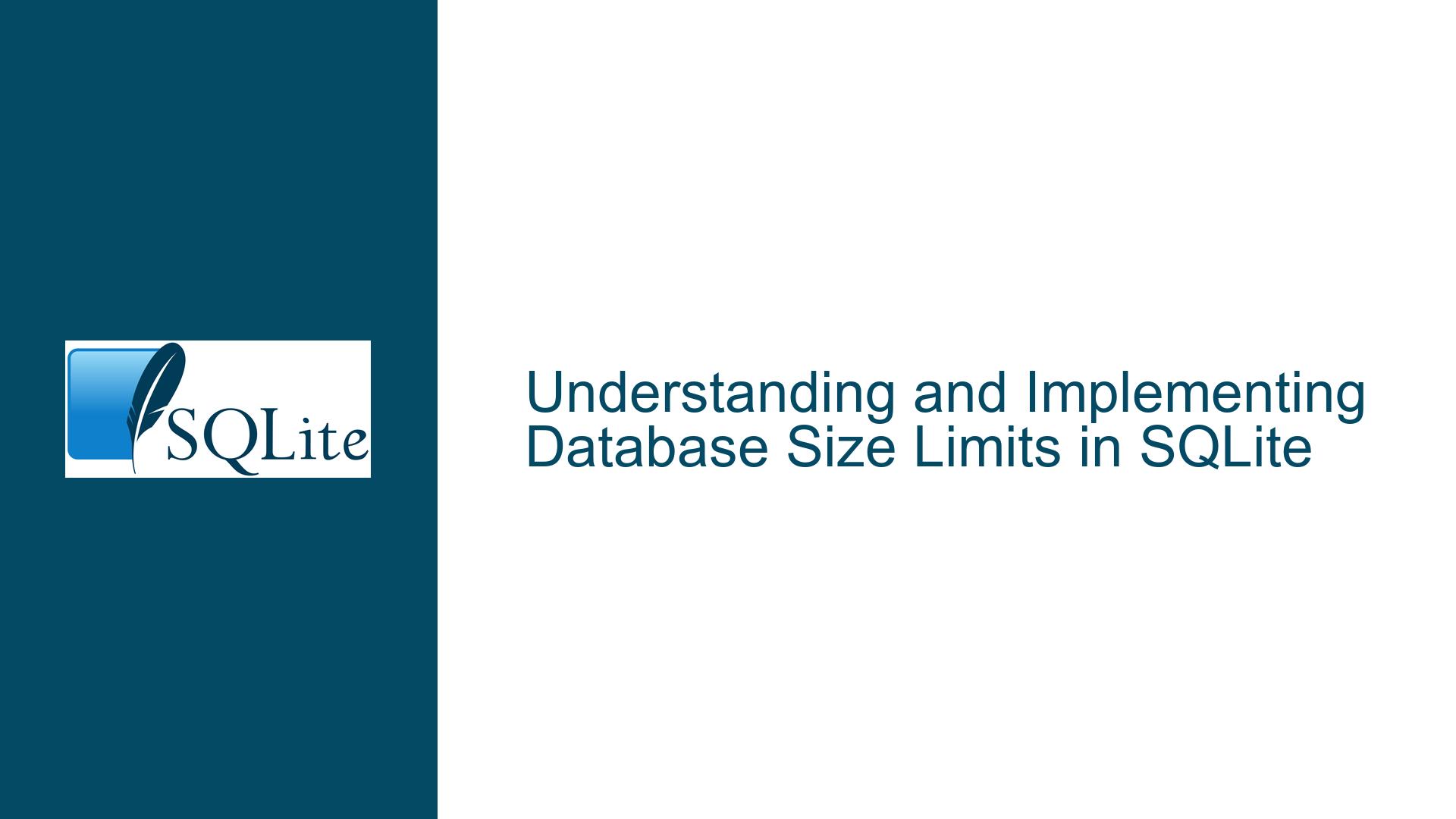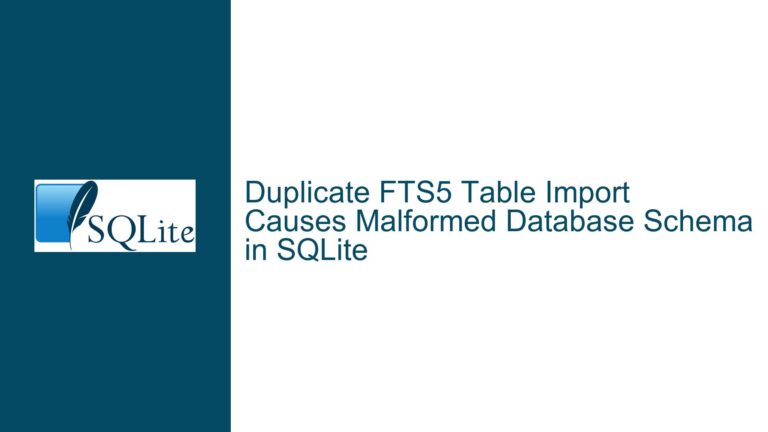and Implementing Database Size Limits in SQLite
SQLite Database Size Limits and SOFT_HEAP_LIMIT Misconceptions
When working with SQLite, one common requirement is to impose a size limit on the database to ensure it does not grow beyond a certain threshold. This is particularly important in embedded systems or applications with limited storage capacity. A frequent misconception is that the sqlite3_soft_heap_limit64 function can be used to limit the database size. However, this function is designed to limit the amount of memory SQLite can allocate for its internal heap, not the size of the database file itself.
The sqlite3_soft_heap_limit64 function sets a soft limit on the amount of memory SQLite can use for its heap. When the heap size approaches this limit, SQLite will attempt to free up memory by releasing unused cache pages. However, if there are no unused pages to release, the limit will not be enforced, and SQLite will continue to allocate memory as needed. This is why setting a SOFT_HEAP_LIMIT of 5MB does not prevent the database from growing beyond 5MB. The SOFT_HEAP_LIMIT is not a mechanism for controlling the size of the database file; it is a mechanism for controlling memory usage.
To impose a hard limit on the size of the database, you must use the PRAGMA max_page_count command. This command sets the maximum number of pages that the database can contain. The size of each page is determined by the PRAGMA page_size setting, which is typically 4096 bytes. By setting the max_page_count, you can effectively limit the size of the database file. For example, if you want to limit the database to 5GB, and the page size is 4096 bytes, you would set the max_page_count to 1310720 (5 * 1024 * 1024 * 1024 / 4096).
It is important to note that the max_page_count limit is enforced at the time of page allocation. If the database already contains more pages than the specified limit, the limit will be set to the current number of pages. Therefore, it is crucial to set the max_page_count before the database reaches the desired size limit. Additionally, the max_page_count limit applies only to the specific database connection that sets it. If you have multiple connections to the same database, each connection must set its own max_page_count limit.
Interrupted Write Operations and Database Size Enforcement
One of the challenges of enforcing a database size limit is dealing with interrupted write operations. When the max_page_count limit is reached, any attempt to insert new data that requires additional pages will result in an SQLITE_FULL error. This error indicates that the database has reached its maximum size and cannot allocate additional pages. However, this error does not provide a mechanism for automatically replacing old data with new data.
In some applications, it may be desirable to replace the oldest rows with new data when the database reaches its size limit. Unfortunately, SQLite does not provide a built-in mechanism for automatically replacing old data. Instead, you must implement this logic in your application code. This involves checking the current page count before attempting to insert new data and, if the limit is reached, deleting the oldest rows to make room for new data.
The PRAGMA page_count command can be used to determine the current number of pages in the database. By comparing this value to the max_page_count limit, you can determine whether the database is approaching its size limit. However, it is important to note that the page_count value may change between the time you check it and the time you attempt to insert new data. Therefore, you must be prepared to handle the SQLITE_FULL error even if the page_count value is below the max_page_count limit.
Another consideration is that deleting rows does not necessarily reduce the number of pages in the database. SQLite uses a technique called "vacuuming" to reclaim unused pages and reduce the size of the database file. However, vacuuming is a relatively expensive operation and may not be suitable for all applications. If you need to ensure that the database size remains below a certain limit, you may need to periodically vacuum the database or use a custom mechanism for managing the size of the database.
Implementing PRAGMA max_page_count and Handling SQLITE_FULL Errors
To implement a hard limit on the size of an SQLite database, you must use the PRAGMA max_page_count command. This command sets the maximum number of pages that the database can contain, effectively limiting the size of the database file. The following steps outline how to set the max_page_count and handle SQLITE_FULL errors in your application.
First, determine the desired size limit for your database and calculate the corresponding max_page_count value. For example, if you want to limit the database to 5GB and the page size is 4096 bytes, you would set the max_page_count to 1310720 (5 * 1024 * 1024 * 1024 / 4096). You can set the max_page_count using the following SQL command:
PRAGMA max_page_count = 1310720;
After setting the max_page_count, you should verify that the limit has been applied correctly by querying the current max_page_count value:
PRAGMA max_page_count;
If the database already contains more pages than the specified limit, the max_page_count will be set to the current number of pages. In this case, you may need to reduce the size of the database before setting the limit.
Next, you must handle the SQLITE_FULL error in your application code. This error occurs when the database reaches its size limit and cannot allocate additional pages. When this error occurs, you have several options for handling it:
Delete Old Data: If your application can tolerate the loss of old data, you can delete the oldest rows to make room for new data. This involves querying the database to identify the oldest rows and deleting them before retrying the insert operation.
Compact the Database: If your application cannot tolerate the loss of data, you can compact the database by vacuuming it. Vacuuming reclaims unused pages and reduces the size of the database file, allowing you to insert new data without exceeding the size limit. However, vacuuming is a relatively expensive operation and may not be suitable for all applications.
Notify the User: If your application cannot delete old data or compact the database, you can notify the user that the database has reached its size limit and prompt them to take action. This may involve exporting data to another database or deleting unnecessary files to free up storage space.
The following code snippet demonstrates how to handle the SQLITE_FULL error by deleting the oldest rows:
int rc = sqlite3_exec(db, "INSERT INTO my_table VALUES (...);", NULL, NULL, NULL);
if (rc == SQLITE_FULL) {
// Delete the oldest rows to make room for new data
rc = sqlite3_exec(db, "DELETE FROM my_table WHERE id IN (SELECT id FROM my_table ORDER BY timestamp ASC LIMIT 10);", NULL, NULL, NULL);
if (rc == SQLITE_OK) {
// Retry the insert operation
rc = sqlite3_exec(db, "INSERT INTO my_table VALUES (...);", NULL, NULL, NULL);
}
}
In this example, the application attempts to insert a new row into the my_table table. If the insert operation fails with an SQLITE_FULL error, the application deletes the 10 oldest rows and retries the insert operation. This approach ensures that the database size remains below the specified limit while preserving as much data as possible.
In conclusion, setting a hard limit on the size of an SQLite database requires careful planning and implementation. By using the PRAGMA max_page_count command and handling SQLITE_FULL errors appropriately, you can ensure that your database remains within the desired size limits. However, it is important to consider the trade-offs involved in deleting old data or compacting the database, as these operations can impact the performance and usability of your application.






